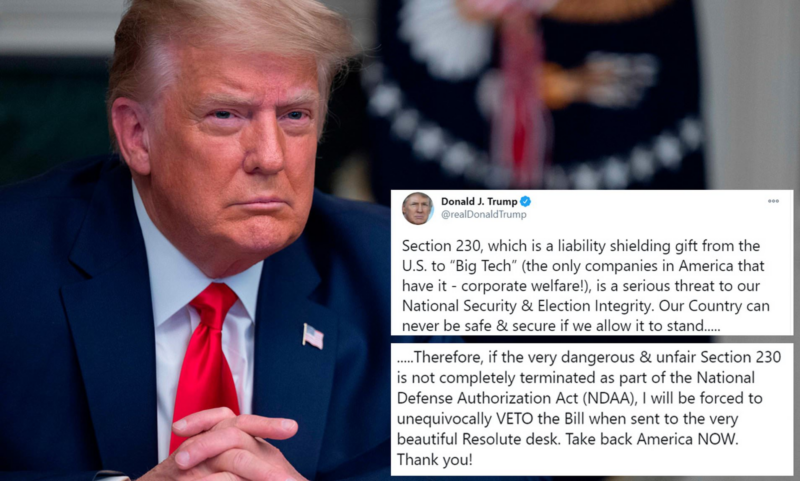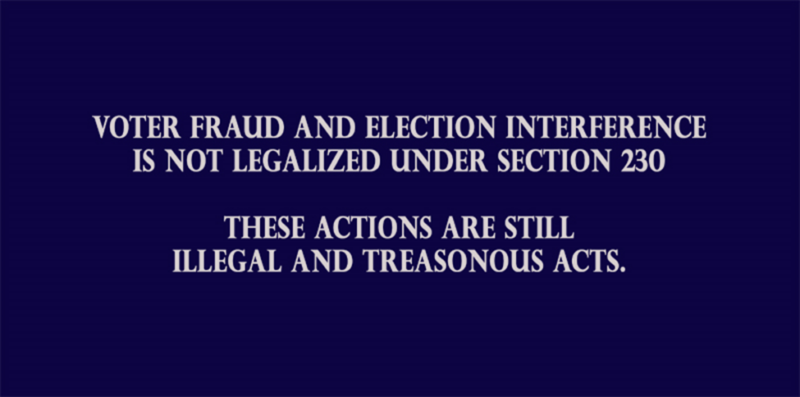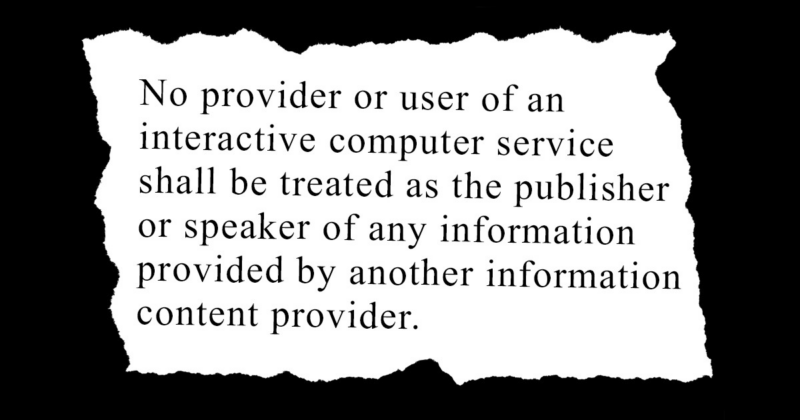Section 230 is no longer serving a good purpose. The question is … did it ever really?
From what we are learning of agency data mining, spying, and the rogue FBI, CIA, NSA and other government agencies… it is looking like Section 230 has always had a sense of false public serving with a trojan horse capacity for those who want to know all about you so they can complete their own public programming. President Trump has said in the past that Section 230 of the 1996 Act is “a serious threat to our National Security & Election Integrity” and called the provision “a liability shielding gift from the U.S. to Big Tech.”

In December of 2020, Trump sent a veto threat the night before the Senate Commerce Committee, chaired by Senator Roger Wicker, R-Mississippi, was set to vote on Trump’s Federal Communications Commission nominee Nathan Simington. Simington was a former telecom lawyer, who was criticized for acting as an arm of the president when he helped author the National Telecommunications and Information Administration’s rulemaking calling for clarification of Section 230 in July. Trump directed the NTIA to file the petition after Twitter in May warned readers to fact-check his posts about unsubstantiated claims of fraud in mail-in voting.
Trump’s push for Simington to replace FCC Commissioner Mike O’Rielly has been criticized as another lame-duck action aimed at revoking Section 230. Trump and other conservatives believe tech companies are biased against conservative political views; however, the social media platforms say they are only trying to stop the spread of false claims and disinformation.
Trump had been against Section 230 for a long time and had been waging war against social media companies for months, claiming they are biased against conservative voices.
It is important to note that Section 230 is not an executive order that he could over throw and change, it is a law that has to been repealed or amended by congress.
Lawmakers from both sides of the aisle have largely rejected a wholesale repeal of Section 230. While legislators have proposed revisions, no concrete legislative steps have been taken.
Therefore, in October 2020 Trump signed an executive order directing executive branch agencies to ask independent rule-making agencies, including the Federal Communications Commission and the Federal Trade Commission, to study whether they can place new regulations on the companies.
Trump tweeted on Thanksgiving in 2020, “For purposes of National Security, Section 230 must be immediately terminated!!!”
The Internet Association, which includes Facebook, Amazon, Google and Twitter, blasted Trump with- “Repealing Section 230 is itself a threat to national security. The law empowers online platforms to remove harmful and dangerous content, including terrorist content and misinformation.”
Trump threatened to veto the defense bill if Democrats didn’t agree to repealing Section 230 because the 24-year-old law provides a vital protection to social media companies and allowed them to ban conservative views which interferred with elections.
The aides suggested Trump’s threat was part of an effort to force revisions to Section 230 and include them in the defense bill.

Section 230 of the Communications Decency Act was enacted in 1996, to help protect online companies from liability from things that are posted on their platforms. It protects the one who owns the site from comments made by others. Which no one should be held responsible for another person’s words or actions. However, it gave Big Tech advantages that other companies don’t have and they abused these advantages and protections by using them to interfere in other people’s rights. Using their platforms to censor others who spoke against their narratives.
President Trump knew that the social media sites were compromised and controlling information in their mis and dis information campaigns. What we are watching now with the Musk Twitter/ FBI agency censorship reveal is the continued efforts to expose the abuse and misuse of Section 230. If Trump had the power to simply change the act, he would have a long time ago. Trump did not have the executive authority to change a law on the books. That process is up to the congress and the senate. The president has the power to approve or to vetoe a law presented. Not to rewrite a law that has already been enacted. He can send a law back to congress with revisions to approve… but it is then up to congress whether they will or will not make those revisions. In short, President Trump’s hands were tied in changing Section 230.

Section 230 also protects all online platform and businesses not just social media in the following manner:
A provider or user of an “interactive computer service” can’t be treated as the “publisher or speaker” of information provided by a third party. The law has a broad definition of “interactive computer service.” It includes almost any online platform that publishes third-party content.
Providers and users of interactive computer services can’t be liable for voluntarily taking down content if the provider believes in good faith that the information is obscene or otherwise objectionable.
This allows a platform social or business to remove unwanted, or derogatory comments that can hurt the business or social platform. Many refer to it removing trolls. So to remove section 230 altogether because someone is abusing their removal privileges is NOT AN ANSWER to social media mis and dis information campaigns. However, proof of abuse of free speech and censorship such as those found being used with the FBI infiltrating and using social media to do their bidding, are illegal practices and in the cases we are now being shown in the Twitter reveal, include election tampering and fraud which is illegal and treasonous.
Which bring us to President Trump and Twitter….
Many of you can hopefully still remember President Trump and Covfefe. How the news media made fun of him for tweeting …

What the word “Covfefe” really meant was a House Bill H.R. 2884, the “Communications Over Various Feeds Electronically for Engagement Act” (COVFEFE Act). This was introduced in the United States House of Representatives on June 12, 2017, during the 115th United States Congress. The bill was intended to amend the Presidential Records Act to preserve Twitter posts and other social media interactions of the President of the United States, and required the National Archives to store such items. H.R. 2884 was assigned to the House Oversight and Reform Committee for consideration. While in committee, there were no roll call votes related to the bill. The bill died in committee.
It was Representative Mike Quigley, Dem of Illinois who introduced the legislation due to Donald Trump’s routine use of Twitter. He stated, “In order to maintain public trust in government, elected officials must answer for what they do and say; this includes 140-character tweets. If the president is going to take to social media to make sudden public policy proclamations, we must ensure that these statements are documented and preserved for future reference”. If enacted, the bill “would bar the prolifically tweeting president from deleting his posts, as he has sometimes done”.
The COVFEFE Act would also see United States law treat American presidents’ personal social media accounts (e.g., Trump’s “@realDonaldTrump” Twitter account) the same as “official” social media accounts (e.g., the “@POTUS” Twitter account).
Some of his tweets have contradicted his agenda by undercutting or contradicting statements of public officials as well as the arguments of U.S. Department of Justice attorneys seeking to defend Trump’s decisions in court. A federal appellate court cited one of Trump’s tweets in upholding a lower court’s order blocking Trump’s Executive Order 13780 from going into effect in 2017. Courts have been clear that Twitter statements can be used as evidence of intent.
This all fed the monster of mis and dis information campaigns and got lots of people looking into the social media matter.
The question isn’t just one… it is several…. was COVFEFE a part of a bigger plan? Was this a plan to get people to look into social media platforms? Or was this a plan to first step the first amendment rights to social media platforms and free speech? Or was this a step toward censorship? Or was this a step toward uncensoring speech? There are many questions to be asked here. Was this a step to censor the president all along? As by going directly to the people, he got his message out without the media bias and spins.

He got his message UNCENSORED AND UNBIASED TO THE PEOPLE WITHOUT A NEWS NARRATIVE AND WRAP UP SMEAR.
Before Trump’s “@realDonaldTrump” Twitter account was suspended, he blocked a number of users, preventing them from viewing his tweets or posting public replies. A group associated with Columbia University filed a lawsuit on behalf of blocked users, called Knight First Amendment Institute v. Trump. Plaintiffs successfully argued that @realDonaldTrump reply threads constituted a “designated public forum” of the same nature to a public meeting, and therefore blocking users based on their political viewpoints violated their constitutional right to freedom of speech. The Second Circuit upheld this ruling on July 9, 2019.
So we have an issue related to free speech that presents a very complicated design of abuse of the Bill of Rights and Free Speech.
Section 230 protects online businesses and social media platforms, but the deep state overreach into social media platforms went beyond protections and abused the rights of protections and became predatory and set up mis and dis information campaigns to ban any messages they decided they wanted to censor and or messages that threatened their narrative.
So what is the answer?
The Hartford Staff explains Section 230 is a foundational component to how the internet works. More recently, it’s become the target of legislation, which can have significant impacts on the tech industry.
In the case of the Columbia University Lawsuit, without Section 230 to protect Twitter from liability they would have to pay for settlements and judgments for its users content. We heard Trump use that as leverage for his Tweets being censored prior to his account being removed. It was President Trump that brought Section 230 out in the open for discussion.
Jay Silver, a partner at Womble Bond Dickinson, a transatlantic law firm explained Section 230. He has served business clients across every industry sector and has expertise in Section 230 litigation, technology and data privacy. He said that for Section 230 to protect a company from liability, it has to meet three criteria:
- The company provides or uses an interactive computer service.
- The plaintiff seeks to hold the defendant liable as the publisher or speaker of the information
- The plaintiff sues the company for information provided by a third party.
Without Section 230, online platforms would have to pay for settlements and judgments if they were sued for content that their users posted.
Silver referred to Google as an example of how Section 230 protected the company. Google was sued, but the company wasn’t liable for a post disparaging a business. That’s because even though the tech business could remove, delete or limit access to content, it chose only to decide to publish or remove the content, rather than edit or substantively change the content.
Silver also explained that Section 230 does not protect online platforms from illegal behavior…
“Negligence and illegal behavior are some of the areas where Section 230 won’t protect an online company. So, it’s important that these businesses understand how their platforms work and how they’re interacting with users.”
Four limits of Section 230 include:
- Negligently designing its website or service, which caused harm to a user.
- Materially contributing to illegality of information or harmful nature of content.
- Failing to warn users of a known danger on the platform.
- Statutory exceptions, such as federal civil rights claims, antitrust claims, Fair Housing Act claims, electronic communications privacy law claims or intellectual property claims.
Does Section 230 Protect E-Commerce and Gig Economy Businesses?
E-commerce and gig economy platforms may have some protection under Section 230. Immunity will come down to the type of claim and how a gig economy service operates, according to Andrew Zarkowsky, Technology Industry Practice Lead at The Hartford.
“It’s not as easy as saying every kind of e-commerce or gig economy company would have immunity under Section 230, and varying laws and regulations add another layer of complexity,” said Zarkowsky.
“For example, an e-commerce business will likely have protection from claims based on representations or omissions in a product description or advertisement because the content usually comes from a third party. But in some states, the company may be viewed as a “seller,” so it can still be liable for defective products.
“For gig economy services, businesses can be liable if the platform encourages unlawful, illegal or harmful conduct.” Read: What Is Section 230? | Section 230 Explained | The Hartford
The Future of Section 230 and its Impact to the Tech Industry rests in the hands of Congress.
Again, this act cannot be thrown out by a President. It is an act that must be changed before congress.
Presently congress is considering 14 bills during the 2021 and 2022 that could amend Section 230. These bills can change the entire scope of how the internet protections have worked for the last twenty years.
For example, the “Disincentivizing Internet Service Censorship of Online Users and Restrictions on Speech and Expression Act,” or the DISCOURSE Act, aims to remove Section 230 protections for “market-dominant” computer services that manipulate algorithms to censor certain materials or viewpoints.
Another bill, the “21st Century Foundation for the Right to Express and Engage in Speech Act,” or 21st Century FREE Speech Act, aims to repeal Section 230 completely. It would also reclassify internet platforms as common carriers, requiring them to provide services to anyone without discriminating against individual users or classes of users based on: political views, religion, and region.
Changes to Section 230 could have serious impacts on how businesses providing cloud services and server hosting work.
Section 230 isn’t a simple law or topic to understand. It holds many facets that directly affect business and user privacy rights and protections. It isn’t a matter of throwing it out, or a quick fix. The matter needs thought out and not have government Marxist type overreach. We are now aware of the many agency hands involved in social media such as the FBI, and the mis and dis information campaigns in EVERYTHING, even CISA and Homeland Security and FEMA. Section 230 has been breeched by federal agencies and this has been illegal thanks to having Section 230 in place and the constitution and bill of rights.
The proposed changes to Section 230 (amendment acts) are not law at this time. Whereas there needs to be some changes in claims and protections in Section 230, this needs to be well thought out and not include anything that interferes with the rights set forth in the constitution. The “save our democracy” congress that has been pushing a global Marxist agenda is not the sort of congress that can be souly trusted in rewriting and amending Section 230. These are among the same ones that have been doing their mis and dis information campaigns and their own sort of reign of terror in their censoring gate keeping efforts. These are the ones we have watched hold their kangaroo courts for the past six years and are presently watching their one sided J-6 patriots and MAGA are terrorists show.
All because of 26 words in Section 230.

That being said, Should Section 230 be repealed or amended? Is it time to yank these words out?
Note: A repeal without replacement is generally done when a law is no longer effective, or it is shown that a law is having far more negative consequences than were originally envisioned.
We are in need of some sort of amending and updating, or changing the way the internet is monitored altogether, but now that the truth is coming out in how the internet has also been used by government agencies and deep state swamp groups as a full throttle propaganda machine, we have to be very careful in amending Section 230 and or repealing and replacing it with a different set of protections. We must get involved to insure that it is amended in a just and fair use manner and not steam rolled into a worse big brother arm of destruction by those out to save their idea of democracy that destroys free speech and free commerce.
So pray that truth, justice, fairness, right to privacy and freedom of speech are protected in any and all of the actions taken and that are made.
Keep on pressing into the Kingdom of God. Press, press, press!
Dianne

